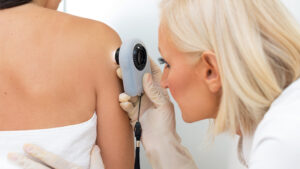Rosacea is a chronic, inflammatory skin condition that primarily affects the face, often causing redness and small bumps. Commonly mistaken for acne, eczema, or other skin conditions, rosacea usually appears on the cheeks, chin, forehead, and nose.
Rosacea is classified into four subtypes:
1. Erythematotelangiectatic Rosacea:
This subtype is characterised by persistent facial redness and flushing. You might also notice visible small blood vessels and experience symptoms like burning, swelling, or scaling.
2. Papulopustular Rosacea:
This form presents with bumps and pimples on the face, similar to acne but with added raised red patches called plaques.
3. Phymatous Rosacea:
Often linked to an enlarged nose due to excess tissue (rhinophyma), this subtype causes skin thickening and irregular nodules. In rare cases, it can affect areas beyond the nose.
4. Ocular Rosacea:
This subtype affects the eyes, leading to symptoms such as watery eyes, burning, stinging sensations, swollen eyelids, and frequent styes.
The exact causes of rosacea are unknown, but factors like family history, H. pylori bacteria, and fair skin may influence its development. Rosacea can be aggravated by triggers such as spicy foods, hot beverages, caffeine, humidity, and corticosteroids.
Here are some key signs and symptoms to watch for:
Excessive Dryness: Rosacea can leave your skin inflamed and sensitive, making it vulnerable to external irritants like dry air and harsh soaps.
Facial Redness: Persistent redness in the cheeks, forehead, chin, and nose is a common early sign of rosacea.
Visible Blood Vessels: Tiny blood vessels on the face may indicate rosacea.
Eye Discomfort: Watery, irritated eyes, puffy eyelids, or frequent styes can be symptoms of ocular rosacea.
With the demand for skincare specialists projected to grow by about 14% from 2016 to 2026, it’s crucial to seek professional advice if you notice any of these symptoms. Contact your dermatologist or local dermatology clinic for a thorough evaluation and appropriate care.



